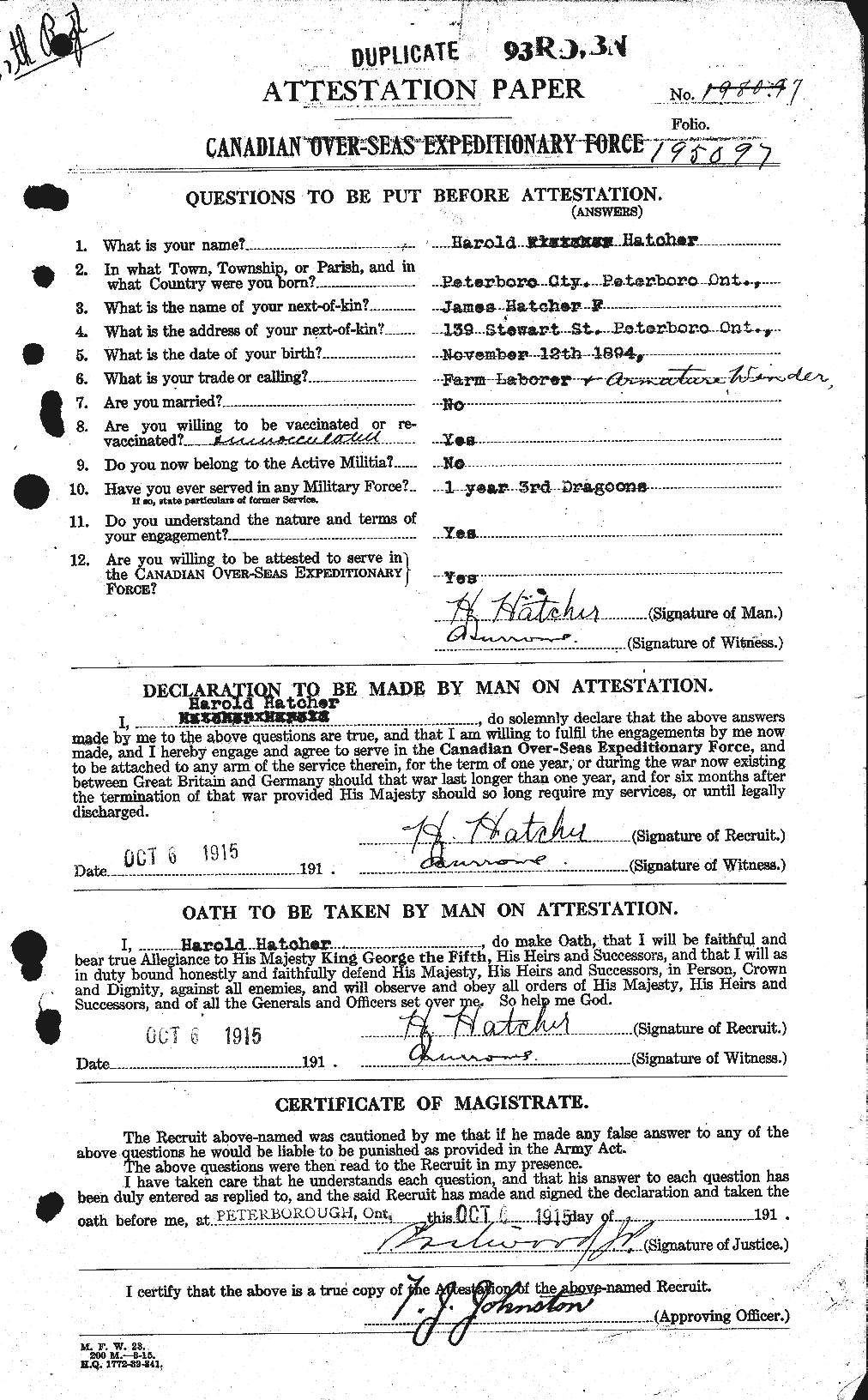

Harold Hatcher

Biography:
Harold Hatcher was born on November 12, 1894. He grew up with his parents James and Laura Jane Hatcher and brother Walter. He lived in Peterborough Ontario on 139, Stewart St The whole family were of the Methodist faith. Before the war broke out Harold worked as a farm laborer and an amateur winder. He never married.
He had reported 1 year of previous military experience with 3rd Dragoons before he enlisted to fight in the First World War at the young age of nineteen on September 20 1915. Harold was 5 foot 5 with brown hair, blue eyes and dark skin tone. After enlisting he created a will leaving all his belongings to his beloved mother. The following December Harold’s brother Walter also enlisted.
After enlisting Harold was assigned to the Army as a private in the Canadian Infantry, 39th Battalion. Harold arrived in England on July 25 1916 on the SS Empress of Britain and was later transferred to the 21st battalion a Brigade Support in the village of Calonne . The 21st Battalion was one of the many Battalions to fight in the trenches for possession of the western front . He served for two years and 3 months, mostly in France. Over the course of the war he made only$1.00 a day as a private.
Tragically Harold Hatcher was killed in action on January 17, 1917.He died during one of the largest raids thus far in the war on the German trenches held near the town Calonne. He was buried in the Marco British Cemetery in Nord, France. On April 22, 1917 three months later his brother Walter was transferred to the the 21st Battalion. Walter survived the war and married.

Harold Hatcher age 20

Harold Hatcher's Attestation Papers
Grave Site:
Harold Hatcher was buried in Marco British Cemetery, in Nord France. The Marco Cemetery is located in Grenay, a small village around 15km south east of Bethune. It is area 1 section M grave 6. The Cemetery originally began in August, 1915 by French troops and it was first used as a British cemetery in January 1916 by the London 47th division. Harold Hatcher is also commemorated on the Peterborough Ontario War Memorial on 499 George St North.


The Peterborough War Memorial
Harold Hatcher's Grave in Nord, France
The 21st Battalion
The 21st Battalion was authorized on November 7th in 1914. The battalion was started in Kingston Ontario and mainly recruited men from eastern Ontario. They departed for Britian on May 6th 1915 but fought most of their battles in France.
The Battalion fought as part of the 4th infantry brigade. The 21st battalion was an infantry battalion and therefore fought all battles on foot. The 21st battalion was one of the many Battalions to engage in trench warfare.The Battalion was one of the Canadian Battalions responsible for helping to take Vimy Ridge in 1917, the 21st battalion also fought in The Somme in both 1916 and 1918 and the Battle of Passchendaele in 1917 along with countless other Battles. On August 30th 1920 the 21st Battalion was disbanded.


21st Battalion Badge
21st Battalion Patch
Propaganda:
Over the course of the war the Canadian Government produced films, magazine articles, radio programs, and posters in support of the war effort. There were even some songs put out to encourage the war effort. Much of the propaganda was meant to appeal to Canadians sense of patriotism. The propaganda would also try to play on peoples emotions mainly the emotion of guilt .People were encourage to use less fuel, eat less meat and support the Government to help troops over seas.
At the beginning of the war enlistment was high but as the war continued mounting casualties in Europe and dropping enlistment put the Government in desperate need of more men in the army. A lot of effort was put into putting out propaganda to convince men to enlist in the military. Often these campaigns used social pressure and the seeming glory of war to encourage men to join the army. Posters were even targeted at women asking them to encourage their husbands to be heroes and go to war.
There were generally two types of propaganda. Positive and negative. The positive seek to make the public feel as if they themselves were part of the war effort and that the war was being won. The negative propaganda was designed to play on the public's fear. The goal was to make people believe that the war might be lost and more soldiers would be killed if people didn't do their bit.
It was not uncommon for the the truth to be distorted in propaganda to make war appear more appealing and noble. The number of enemy casualties was often exaggerated while the number of wounded and killed Allied soldiers was made to appear low. The government hoped to inspire fear and therefore increase enlistment in citizens by portraying the enemy troops, especially the Germans as inhumanly cruel barbarians. Planning to invade and destroy the civilized world. To do this they would publish stories from Belgium refugees about the German invasion. While this was meant to recruit soldiers and sparked intolerance against immigrants from enemy countries in Canada


Propaganda Poster Encouraging Citizens to Save Food
Propaganda Poster Encouraging Men to Enlist
Propaganda poster depicting the Germans

More Examples of Propaganda in a Photo Story
Letters Similar to those Harold Hatcher would have sent during the war

